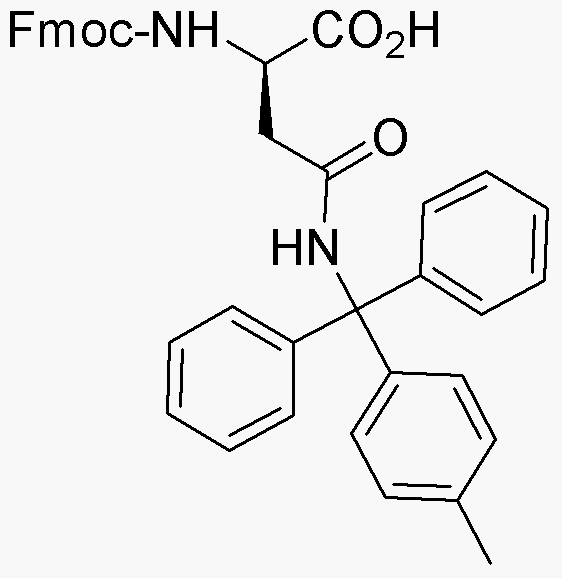Na-Fmoc-Ng-4-methyltrityl-D-asparagine is widely utilized in research focused on:
- Peptide Synthesis: This compound serves as a protective group in solid-phase peptide synthesis, allowing researchers to construct complex peptides with high purity and yield.
- Drug Development: It plays a crucial role in the design of peptide-based therapeutics, particularly in targeting specific biological pathways, which is essential for developing new medications.
- Bioconjugation: The chemical is used in bioconjugation processes, enabling the attachment of peptides to various biomolecules, enhancing the efficacy of diagnostics and therapeutics.
- Research in Neuroscience: It is applied in studies investigating neuropeptides, contributing to the understanding of neurological functions and potential treatments for neurodegenerative diseases.
- Protein Engineering: The compound assists in the modification of proteins, allowing scientists to create novel proteins with tailored functions for various industrial applications.
General Information
Properties
Safety and Regulations
Applications
Na-Fmoc-Ng-4-methyltrityl-D-asparagine is widely utilized in research focused on:
- Peptide Synthesis: This compound serves as a protective group in solid-phase peptide synthesis, allowing researchers to construct complex peptides with high purity and yield.
- Drug Development: It plays a crucial role in the design of peptide-based therapeutics, particularly in targeting specific biological pathways, which is essential for developing new medications.
- Bioconjugation: The chemical is used in bioconjugation processes, enabling the attachment of peptides to various biomolecules, enhancing the efficacy of diagnostics and therapeutics.
- Research in Neuroscience: It is applied in studies investigating neuropeptides, contributing to the understanding of neurological functions and potential treatments for neurodegenerative diseases.
- Protein Engineering: The compound assists in the modification of proteins, allowing scientists to create novel proteins with tailored functions for various industrial applications.
Documents
Safety Data Sheets (SDS)
The SDS provides comprehensive safety information on handling, storage, and disposal of the product.
Product Specification (PS)
The PS provides a comprehensive breakdown of the product’s properties, including chemical composition, physical state, purity, and storage requirements. It also details acceptable quality ranges and the product's intended applications.
Certificates of Analysis (COA)
Search for Certificates of Analysis (COA) by entering the products Lot Number. Lot and Batch Numbers can be found on a product’s label following the words ‘Lot’ or ‘Batch’.
Numéro de catalogue
Numéro de lot/série
Certificates Of Origin (COO)
This COO confirms the country where the product was manufactured, and also details the materials and components used in it and whether it is derived from natural, synthetic, or other specific sources. This certificate may be required for customs, trade, and regulatory compliance.
Numéro de catalogue
Numéro de lot/série
Safety Data Sheets (SDS)
The SDS provides comprehensive safety information on handling, storage, and disposal of the product.
DownloadProduct Specification (PS)
The PS provides a comprehensive breakdown of the product’s properties, including chemical composition, physical state, purity, and storage requirements. It also details acceptable quality ranges and the product's intended applications.
DownloadCertificates of Analysis (COA)
Search for Certificates of Analysis (COA) by entering the products Lot Number. Lot and Batch Numbers can be found on a product’s label following the words ‘Lot’ or ‘Batch’.
Numéro de catalogue
Numéro de lot/série
Certificates Of Origin (COO)
This COO confirms the country where the product was manufactured, and also details the materials and components used in it and whether it is derived from natural, synthetic, or other specific sources. This certificate may be required for customs, trade, and regulatory compliance.


